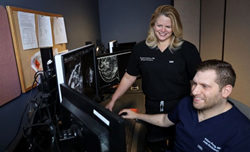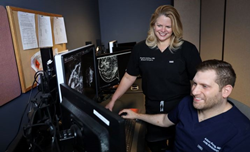
Dr. Angela Keleher and Dr. Adam Fang review a patient scan.
“This is a patient-centered advancement in breast cancer surgery,” said Dr. Keleher.
PITTSBURGH and ERIE, Pa. (PRWEB)
March 17, 2022
Allegheny Health Network (AHN) breast cancer specialists are among the first in this region to use magnetic seed technology to precisely locate non-palpable malignant breast tumors in preparation for surgery. The technology known as the Magseed® marker and created by Endomag, is a more efficient and effective alternative to the wire localization methods that have been used by radiologists and surgeons for nearly three decades.
Breast cancer is the most common form of cancer in women, with 1.7 million new cases diagnosed globally every year. The positive impact of heightened breast cancer awareness has led to earlier detection of the disease, which has doctors now treating smaller tumors than ever before.
“Because small tumors are detected by imaging and not physical exam, we use localization techniques more commonly to guide our surgical resections,” said AHN surgical oncologist Angela Keleher, MD, Director of Breast Surgery. “We are thrilled to offer our patients treatment with Magseed® and the Sentimag® platform, which not only helps minimize pre-surgery discomfort, but allows the surgeon to target the tumor within the breast tissue with greater accuracy and potentially helps us avoid unnecessary removal of the patient’s lymph nodes.”
Localization of the breast tumor is performed by an AHN radiologist using mammography or ultrasound imaging guidance. Previously, this was done the same day as the patient’s surgery by inserting a wire into the tumor, leaving a length of it extending from her breast. “Wire localization can be inconvenient and awkward for the patient,” said AHN radiologist Adam Fang, MD, Director of Breast Imaging. “Aside from having to arrive at the hospital extra early on the day of surgery to have the wire inserted, the patient had to contend with it resting on the outside of the breast until it was time for her surgery, which could be up to several hours,” said Dr. Fang.
The Sentimag® localization system acts like a metal detector and uses magnetism to locate the cancerous tissue marked with the Magseed®. The Magseed® marker is a stainless steel fragment about the size of a grain of rice that may be implanted in the breast at any time before surgery using local anesthetic. “From the patient’s perspective, it’s similar to having a needle biopsy,” said Dr. Fang. Once implanted, the seed causes no discomfort.
In the operating room, the surgeon uses a magnetic sensing probe to pick up the signal emitted by the seed to determine exactly where the tumor is located. “The precision and accuracy of Magseed® localization allows our surgeons to make smaller, more targeted incisions to remove the cancerous tissue while preserving as much healthy tissue as possible, which is always our goal,” said Dr. Keleher.
About 20 percent of all breast cancers are ductal carcinoma in situ (DCIS) or non-invasive Stage 0 breast cancer. While many of these can be successfully treated with lumpectomy, some patients require mastectomy to remove all the cancer. Endomag’s Magtrace® lymphatic tracer is instrumental in helping non-invasive breast cancer patients keep their lymph nodes, which are typically removed during mastectomy surgery for DCIS.
“When performing a mastectomy for a patient, the surgeon will commonly perform a sentinel lymph node biopsy at the same time, in case the final pathology report on the breast shows the cancer is invasive,” said Dr. Keleher. The downside to removing lymph nodes in the armpit is that this may contribute to lymphedema (swelling), pain or scarring.
For patients with DCIS who are having a mastectomy, just before operating, the surgeon injects a tracer into the breast that contains protective coated iron oxide, known as Magtrace®. These tiny iron particles will enter the lymphatic system and travel to the node most likely to contain cancer, the sentinel node. Surgeons can identify these nodes with the magnetic sensing probe, which makes an increasingly high-pitched noise similarto a metal detector when it closes in on the stainless steel and iron oxide.
Magtrace® helps enable a new procedure called delayed sentinel lymph node biopsy for DCIS patients undergoing a mastectomy. With Magtrace®, the surgeon need not perform the sentinel node biopsy as part of the mastectomy surgery and can wait for the final pathology on the breast to return.
“If it is upgraded to invasive cancer, which occurs in about 20 percent of patients, we can still go back and perform the sentinel node biopsy because the tracer remains in place for about a month,” said Dr. Keleher. “However, if the pathology report shows the cancer is DCIS, or non-invasive, then we’ve saved her from having an unnecessary procedure.”
One clinical study involved the use of Magtrace® in 189 women with DCIS who were at high risk for invasive cancer. All the women underwent either lumpectomy or mastectomy, with 78 percent of them being saved from having a sentinel lymph node biopsy unnecessarily.
Additionally, all the delayed sentinel lymph node biopsies were performed successfully using Magtrace® on the 47 patients whose pathology was positive for invasive breast cancer.
“This is a patient-centered advancement in breast cancer surgery,” said Dr. Keleher. “Patients understand the risk associated with losing their lymph nodes, and when I assure the patient there is a good chance we may not need to excise the lymph nodes but have injected the tracer so we are prepared, they are pleased.”
All these Endomag technologies are in use at AHN hospitals where breast cancer surgery is performed, including AHN Wexford Hospital, Allegheny General Hospital, West Penn Hospital, Allegheny Valley Hospital, AHN Forbes Hospital, AHN Jefferson Hospital, AHN Saint Vincent in Erie and AHN Monroeville Outpatient Surgery Center.
Share article on social media or email:

